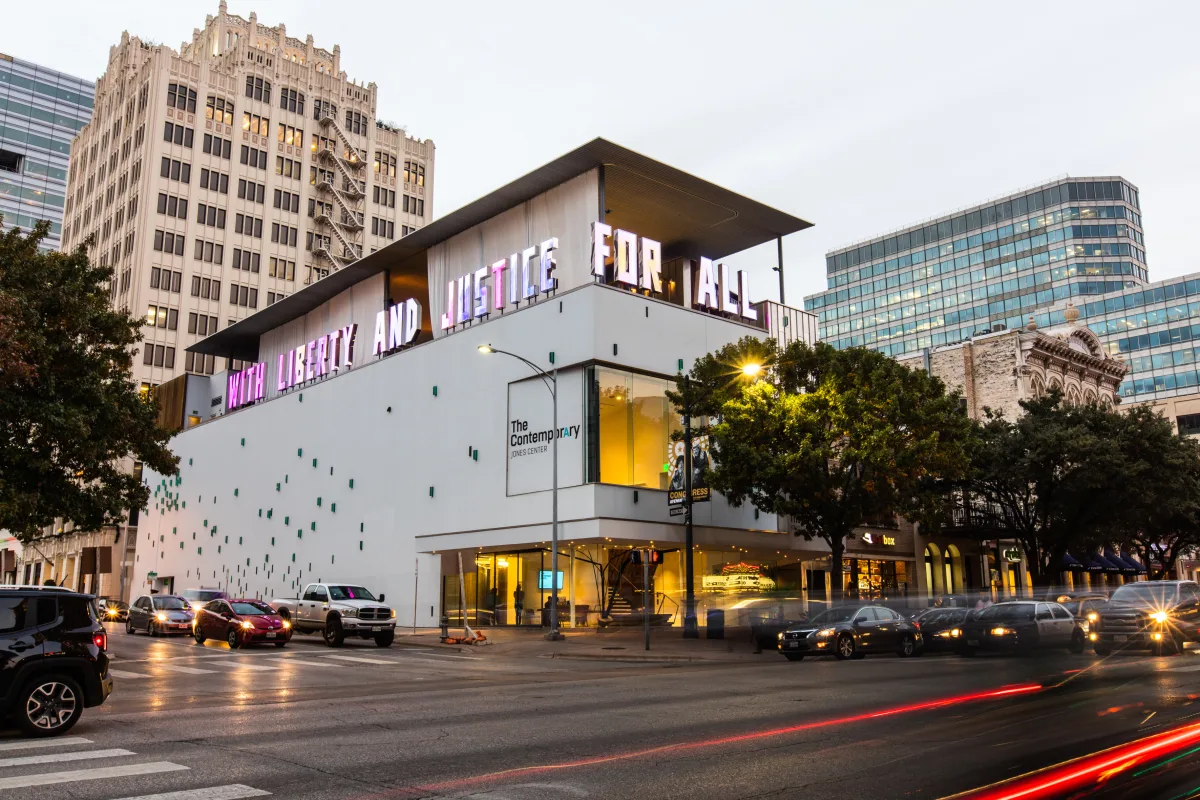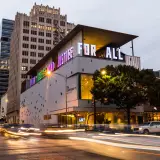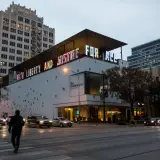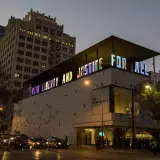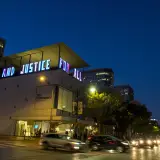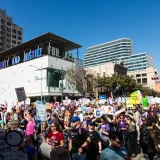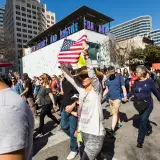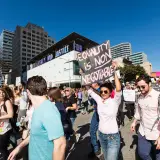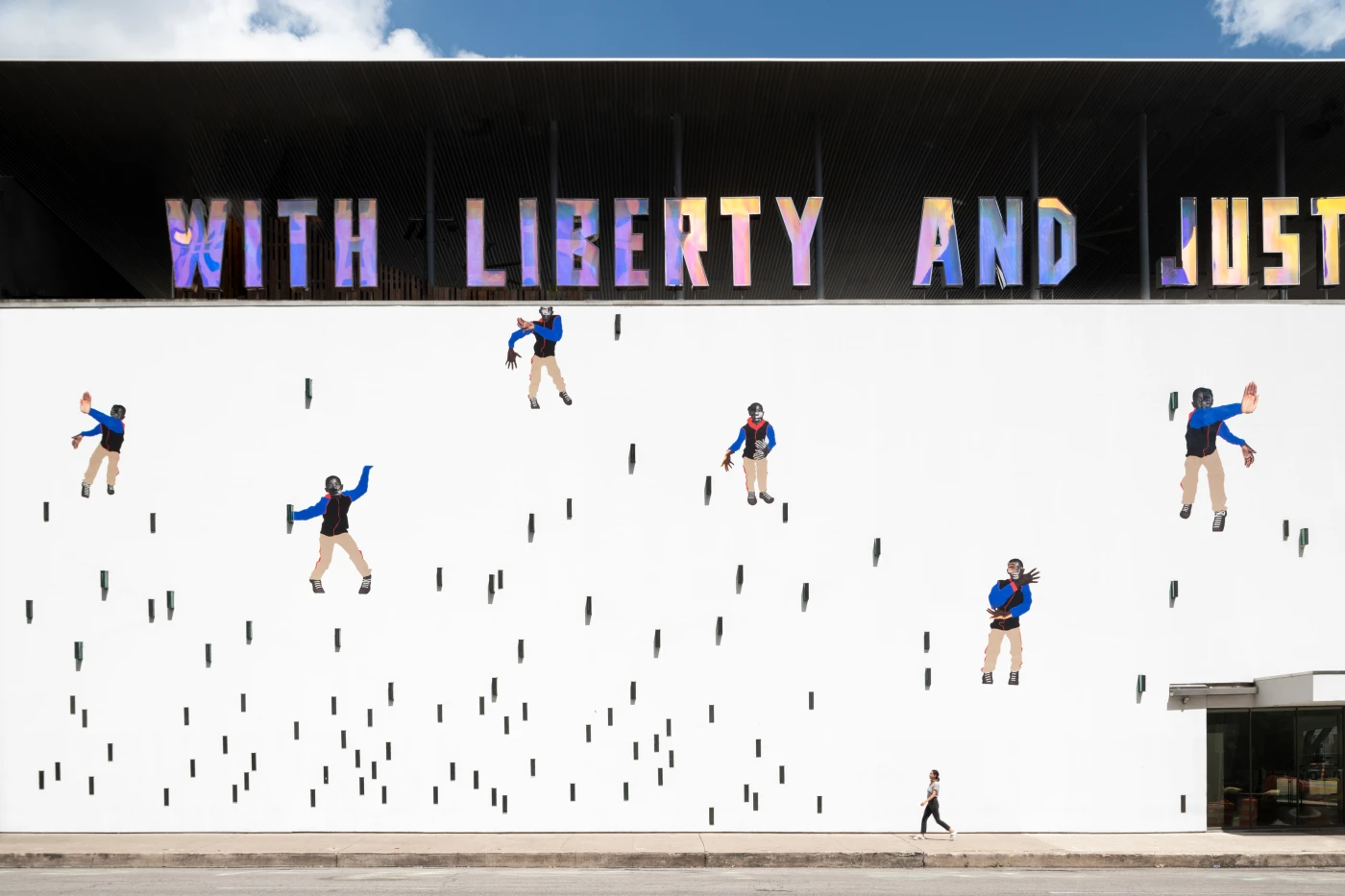Jim Hodges, 'With Liberty and Justice for All (A Work in Progress)' On View at The Moody Rooftop at the Jones Center
"The impermanence and fragility of the human experience, inspired by the overlooked corners of everyday life, run central to the work of ' (American, born 1957 in Spokane, Washington). Quotidian materials—including glass, steel, crystal, plastic, tape, paper, rubber, foil, mirrors, metals, fake flowers, scarves, used clothing, ink, paint, makeup, and even saliva—become the basis for his simple but profound gestures, manifested as sculptures, installations, works on paper, videos, and performances. Following a previous generation of artists working in found and 'poor' materials and advocating for a dematerialized form of art making, namely 1960s and 1970s precursors such as Eva Hesse, Marisa and Mario Merz, Paul Thek and Richard Tuttle, as well as 1970s minimalist and conceptualist artists including Dan Flavin, Ellsworth Kelly and Sol LeWitt, Hodges’s practice embraced ephemerality and the handmade in both concept and material.
As a gay artist, Hodges was deeply enmeshed in the culture wars and AIDS epidemic of the late 1980s and 1990s, and his beginnings can also be contextualized within a deeply fraught period in which many artists, facing censorship, were activists and political outliers. However, like the work of his friend, the artist Felix Gonzalez-Torres, Hodges’s response was not heavy-handed politicism but disarmingly simple, sometimes beautiful, and seemingly innocuous objects and installations that often engaged the viewer in an immersive or even playful manner while serving as Trojan horses for powerful political messages. Formal aestheticism, marked by an affinity toward beauty, is an important element to Hodges’s practice but exists as only the first of many layers, the initial 'web'—and the artist quite literally portrays the spiderweb as a frequent protagonist in his visual lexicon—that entangles the viewer into deeper conceptual, social, and emotional underpinnings. Recurring themes include a desire for equality for oppressed and minority communities, a meditation on the inevitable passage of time and waning of the corporeal body, and a quiet optimism, projected through universal elements that tap into the individual emotions and experiences of each viewer.
Alongside these themes, Hodges’s work has expanded in recent years beyond fragility and ephemerality to explore situations of permanence and timelessness. Characteristic of his use of succinct but powerful gestures, as well as his interest in language to convey open-ended concepts, 'With Liberty and Justice for All (A Work in Progress)', 2014, consists of the title’s words “With Liberty and Justice for All” spelled out in seven-foot-tall letters spanning two sides of The Contemporary Austin’s Moody Rooftop at the Jones Center. During the day, the letters’ iridescent, mirrored surfaces oscillate between blues, purples, oranges, and pinks, reflecting the environment around them. At dusk, the letters remain visible, lit from within to transform the work into a magnificent sculpture of color and light. The words themselves proclaim the fraught but aspirational tenet of this country’s Pledge of Allegiance, one that has complicated roots in religion and patriotism and that has so often been misused and denied, yet embodies an eternal and ongoing ideal (a “work in progress”).
Beginning with a previous version of the work installed on the ground level outside the Aspen Art Museum in 2014, this iteration of 'With Liberty and Justice for All (A Work in Progress)' becomes part of the fabric of the Jones Center building, located a few blocks south of the State Capitol and visible to passersby from the street in a democratic, art-for-all gesture. The work’s use of large-scale text has precedent in an earlier text piece by Hodges, 'Don’t Be Afraid', 2004, in which the artist invited delegates of the United Nations to translate the words of the piece’s title into their own languages and handwriting, then enlarged the responses into a monumental mural.
In conjunction with the debut of Hodges’s work in the Texas state capital during an election year, a series of public programs and community engagements were initiated by The Contemporary Austin on behalf of the artist, bringing the work to underserved populations and fostering engagement with the city on broader social and political levels. As the artist has said, “When engagement with art is happening, there’s an opportunity for change.”(1) Seen as a continuation of Hodges’s dedication to the existentials—love, nature, childhood, religion, sexuality, and mortality—it would be hard to imagine a work more poignantly resonant here, and for our times."
(1) Jim Hodges, quoted in Dorothy Spears, “For Jim Hodges, a Survey of a Career Reflecting on Life,” The New York Times Arts Section, October 25, 2013.
Text by Heather Pesanti (Chief Curator and Director of Curatorial Affairs, The Contemporary Austin, Texas)
